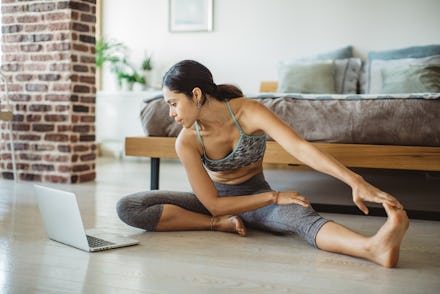How to not screw up your at-home workouts, according to trainers

Gyms are off-limits right now (thanks again, coronavirus), but that doesn't mean we have to emerge from this pandemic as soft, noodle-armed sloths with high cholesterol and blood pressure. Exercise not only strengthens our immune systems, it can also help us stay in good enough physical and mental health to manage both crisis and cabin fever. Unfortunately, it’s easy to make mistakes when you’re exercising without the guidance of a trainer, coach, or a roomful of people whose form you can peep. And the last thing we all need right now is an injury. I talked to two experienced, passionate trainers about the most common workout mistakes people make at home and how we can avoid them.
Not researching proper form
“I think the most common mistakes are due to a lack of awareness,” says Maillard Howell, personal trainer and managing partner at a CrossFit in Brooklyn. The awareness he’s referring to is that of your body alignment and form. When you’re working out on your own, you might not be paying attention to this, but Howell often sees folks flaring out their elbows in push-ups, tugging on the neck during sit-ups, and not engaging the body in plank. These details might seem minor, but they’re not — they’ll dictate how effective your set will be and also whether you’ll be in pain later.
“These errors can be fixed by doing a little research,” Howell says. When you’re planning out your home workout, take the time to explore online resources and tutorials that will show you what good form looks like, and while you’re working out, make sure you aren’t just going through the motions. This can be tricky since trainers don't all agree on what the "perfect form" is for a certain exercise, but roll with a source you trust and always pay attention to how your body feels.
I’m all for this research, though. With so much uncertainty in our lives right now, doesn’t it sound kind of soothing to perfect your squat form?
Not planning workouts with established goals in mind
“If you’re stuck at home, write out a plan that’s consistent with your goals,” says Nicole Ferrier, a Florida-based fitness coach who trains many clients online. Ferrier and Howell agree that not having specific goals is a really common mistake. Howell sees a lot of folks trying to follow every fitness trend, hopping on whichever bandwagon that seems the most effective or like a “quick fix.” This is particularly tempting now, when we’re thrown off our routines and being offered a smorgasbord of workout options. But both him and Ferrier suggest sticking with an approach for two weeks before you switch it up. “If you don’t have solid structures in place, you can’t improve or test your strength,” she says.
Make a plan and keep it simple. “Split your days into upper body day, lower body day, aerobic day, rest day, and total body day,” Howell advises. He really stresses the importance of that rest day, too. “With the limited equipment at home, sessions should be focused around a finite number of bodyweight movements,” Howell says. “The chance of overtraining a specific body part is high and in turn risk of injury.”
Integrating too many new things at once
Ferrier also says that, while you shouldn’t be scared to try new things, you do need to ease your body into them. “People are jumping around a lot when they’ve never jumped before,” she says. I can feel my knees cringe when she says this. She suggests building up to new levels of impact and intensity to reduce the chance for injury. If your body is used to working out on machines that greatly lessen the impact on the body, she explains, it can be dangerous to start running all the time. High intensity cardio is great if you build up to it, but if you don’t, you can hurt yourself or just burn out, and no one needs that right now.
Not engaging with a community
Howell and Ferrier agree that staying inspired is key right now, since we’re not all in the same room and therefore unable to feed off each other’s workout energy. Howell suggests joining social media challenge groups to help keep you accountable. And if you’re really motivated by the exhibitionist factor, now you have the whole world watching, says Ferrier. “Turn on Instagram Live,” she says, “if you have experience with group exercise, you already know how to perform for other people when you don’t feel like working out.”
Doing something you "should" do versus what you find fun
The most important thing, Howell and Ferrier agree, is to have fun. This pandemic is not purgatory. You can have a good time, and working out is a great way to do that. With a little quick searching, you also might find that you have more camaraderie, and help, than usual. If you’re feeling lost about how to set up a workout plan or how to get your form right, DM someone or start a discussion in the comments of a post. “Ask for help,” Howell says. “Social media has a plethora of experts and you can pick their brains.”
We are shining a spotlight on some of the millions of small businesses now challenged by COVID-19. This is part of an ongoing commitment our parent company, Bustle Digital Group, is making to support small businesses throughout the entire month of May. Tell us about your favorite small business on social media using #SmallBusinessSalutes.